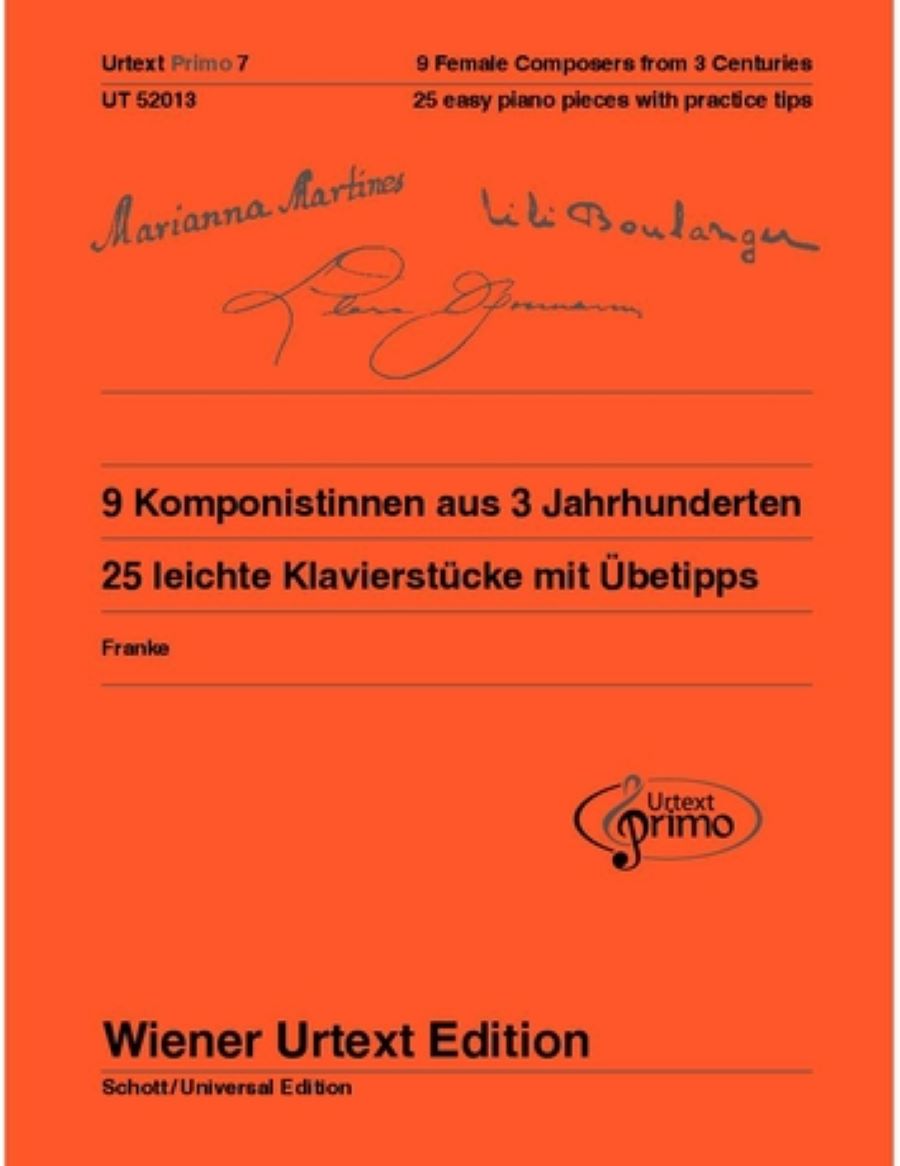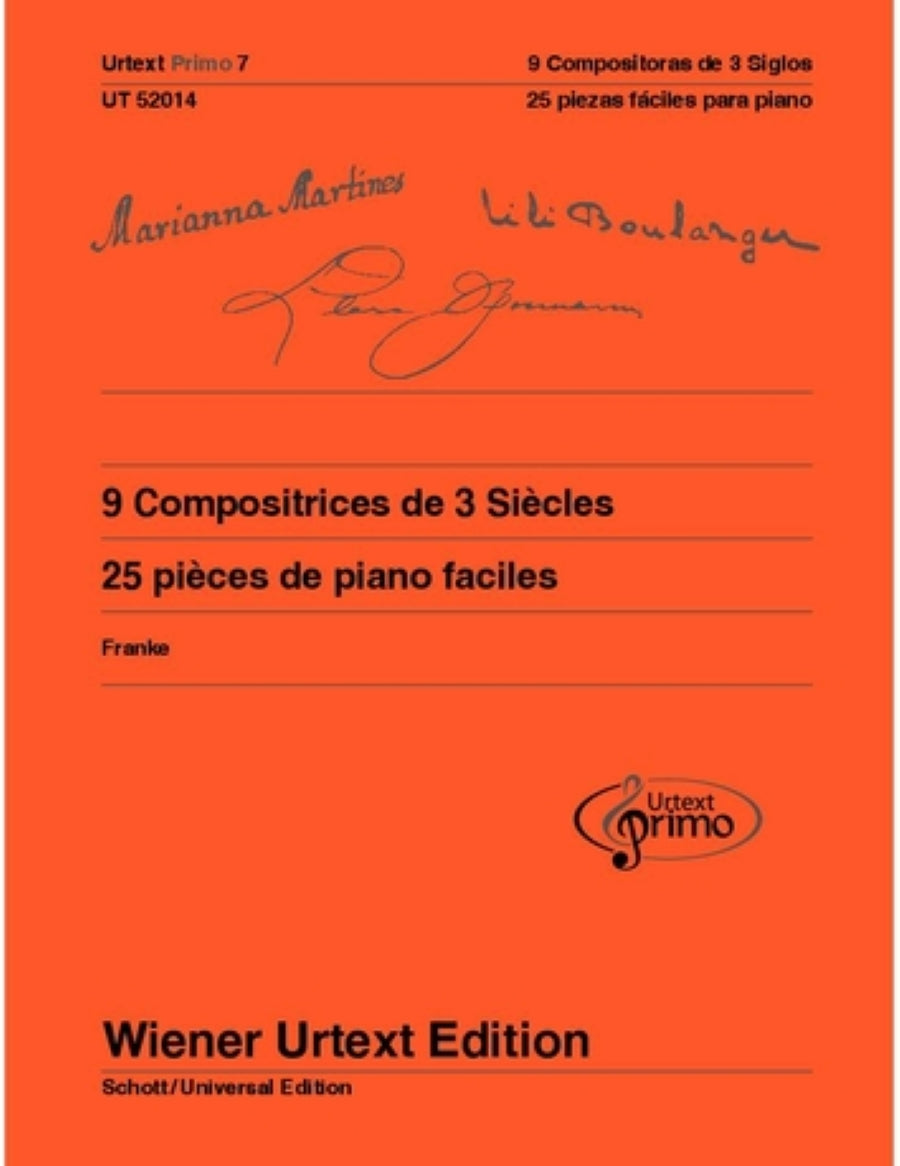9 Female Composers from 3 Centuries: 25 Easy Piano Pieces
In stock and typically ships within 1 business day.
- Composers: Fanny (Mendelssohn) Hensel (1805-1847), Clara Schumann (1819-1896), Mélanie Bonis (1858-1937), Marianna Martines (1744-1812), Louise Farrenc (1804-1875), Chiquinha Gonzaga (1847-1935), Marie Jaëll (1846-1925), Lili Boulanger (1893-1918), Elisabetta de Gambarini (1730-1765)
- Instrumentation: Piano, Harpsichord
- ISMN:
- Size: 9.1 x 12.0 inches
- Urtext / Critical Edition
Description
The 7th volume of the Urtext Primo Series features the works of only female composers. in line with the level of difficulty of the Urtext Primo Series (Grades 3–6), the range of composers has been expanded from three to nine, thus offering a wider range of composers and styles. The music included covers three centuries, which pays tribute to the original concept of featuring three composers in each of volumes 1–6.
Elisabetta Gambarini and Marianna von Martines represent the 18th century, whereas 19th century music includes works by Louise Farrenc, Fanny Hensel, Clara Schumann, Francisca Gonzaga and Marie Jaëll. The 20th century is featured in the music of Mélanie Bonis and Lili Boulanger. As all other Urtext Primo volumes, the pieces come with playing and practice tips, as well as biographical information and a repertoire chart arranged according to the indicative difficulties of the music.
Works:
- Gavotta, No. 13 from Gambarini: Lessons for the Harpsichord Intermix'd with Italian & English Songs, Op. 2
- Giga, No. 14 from Gambarini: Lessons for the Harpsichord Intermix'd with Italian & English Songs, Op. 2
- March from Sonata No. 4 from Gambarini: The 6 Sets of Leessons for the Harpsichord, Op. 1
- Cariglion, No. 8 from Gambarini: Lessons for the Harpsichord Intermix'd with Italian & English Songs, Op. 2
- Tambourin, No. 7 from Gambarini: Lessons for the Harpsichord Intermix'd with Italian & English Songs, Op. 2
- Martines: Tempo di Minuetto
- No. 1 from Farrenc: 20 Etudes of Medium Difficulty (Vingt études de moyenne difficulté), Op. 42
- Nos. 4, 10, 11, & 18 from Farrenc: 25 Easy Etudes (Vingt cinq études faciles), Op. 50
- Hensel: Pastorella (1846)
- No. 2 from Cl. Schumann: 3 Romances, Op. 21
- Scherzo, No. 4 from Cl. Schumann: 4 Flüchtige Stücke, Op. 15
- Jaëll: Grisaille, No. 3 from Les Jours pluvieux (1894)
- Jaëll: En querelle, No. 5 from Les Jours pluvieux (1894)
- Jaëll: On pleure, No. 8 from Les Jours pluvieux (1894)
- Jaëll: On rêve au beau temps, No. 12 from Les Jours pluvieux (1894)
- Jaëll: Chanson berçante
- Gonzaga: Yo te adoro, Op. 18
- Frère Jacques, No. 6 from Bonis: Scènes enfantines, Op. 92
- Bébé s'endort, No. 7 from Bonis: Scènes enfantines, Op. 92
- Bonis: Méditation, Op. 33
- L. Boulanger: D'un Jardin Clair
Publishers use a lot of words to describe what they sell, and we know it can be confusing. We've tried to be as clear as possible to make sure you get exactly what you are looking for. Below are descriptions of the terms that we use to describe the various formats that music often comes in.
Choral Score
A score for vocalists that only contains the vocal lines. The instrumental parts are not there for reference. Generally, cheaper than a vocal score and requires multiple copies for purchase.
Facsimile
Reproductions of the original hand-written scores from the composer.
Full Score
For ensemble music, this indicates that the edition contains all parts on a single system (there are not separate parts for each player). In larger ensembles, this is for the conductor.
Hardcover
Hardbound. Generally either linen-covered or half-leather.
Orchestral Parts
Similar to a wind set, this is a collection of parts. In the case of strings, the numbers listed are the number of copies included, though generally these are available individually (often with minimum quantities required).
Paperback
When publishers offer multiple bindings (e.g. hardcover) or study scores, this is the "standard" version. If you're planning to play the music, this is probably what you want.
Performance / Playing Score
A score of the music containing all parts on one system, intended for players to share. There are not separate parts for each player.
Set of Parts
For ensemble music, this indicates that there are separate individual parts for each player.
Solo Part with Piano Reduction
For solo pieces with orchestra, this is a version that contains a piano reduction of the orchestra parts. For piano pieces, two copies are typically needed for performance.
Study Score
A small (think choral size) copy of the complete score meant for studying, and not playing. They make great add-ons when learning concertos and small chamber works.
Vocal Score
A score prepared for vocalists that includes the piano/organ part or a reduction of the instrumental parts.
Wind Set
For orchestral music, this is a collection of wind and percussion parts. The specific quantities of each instrument are notated.
With Audio
In addition to the printed music, the edition contains recordings of the pieces. This may be an included CD, or access to files on the internet.
With / Without Fingering (Markings)
Some publishers prepare two copies - a pure Urtext edition that includes no fingering (or bowing) suggestions and a lightly edited version that includes a minimal number of editorial markings.



